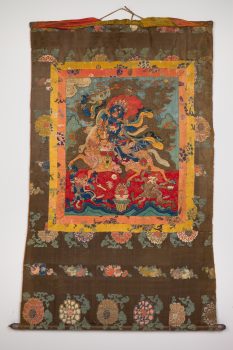Mongolia
18th century


Mongolia
18th century


Magzor Gyalmo (Mongolian: Chog tegulder okin tngri), Queen Who Repels Armies, is a wrathful emanation of the goddess Sarasvati and the special protector of the Dalai Lamas.Mongolians became especially known for their large appliqués, examples of which can reach several stories tall. Scraps of multicolored Chinese silks in various patterns were cut to shape and cleverly integrated into a complex rendering. A variety of embroidery stitches and gold couching (gold-wrapped horsehair fastened to the appliqué with small stitches at regular intervals) delineate the details. Especially distinctive of Mongolian appliqué are tiny seed pearls and small coral beads stitched onto the textile surface. In general, sacred textiles such as this were designed by monks for important ritual occasions, and they were stitched mostly by women.
A kind of energy that can be used, individually and collectively, to effect change.
While the primary religious goal for followers of Buddhism is enlightenment, many of the practices also serve secular goals related to daily life, including ethical conduct and cultivating well-being.
Prescribed practices that carry symbolic meaning and value within a specific tradition and are intended to attain a desired outcome. Rituals are usually done as part of a ceremony or regular routine.
Protectors of Buddhist teachings who destroy obstacles that impede the path to enlightenment. The more frightening and gruesome their appearance, the greater their power.
Mongolians have been widely active in the Tibetan Buddhist world, playing a key role in Tibetan culture, politics, and relations with China. In the 13th century, the Mongol Empire—the largest contiguous empire in world history—facilitated the spread of Tibetan visual culture.
Get the latest news and stories from the Rubin, plus occasional information on how to support our work.